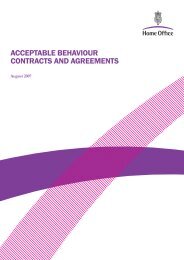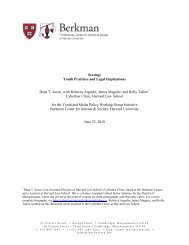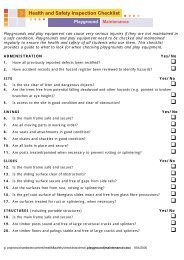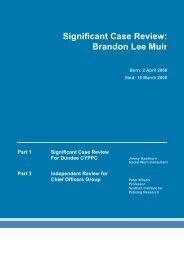Download PDF - Fair Play For Children
Download PDF - Fair Play For Children
Download PDF - Fair Play For Children
Create successful ePaper yourself
Turn your PDF publications into a flip-book with our unique Google optimized e-Paper software.
18.<br />
19.<br />
20.<br />
Completion of level 2 should allow most children to cycle to school (other than those with<br />
difficult journeys). Of course the skills learnt can also be used for other journeys, including those<br />
to play areas, and will become a life skill.<br />
On 21 January this year, the Secretary of State for Transport announced that, through Cycling<br />
England, government is investing a record £140 million in cycling over the next three years.<br />
Amongst a variety of projects that Cycling England is taking forward, an extra 500,000 children<br />
will have access to National Standard Cycling Training by 2012.<br />
We are also working with British Cycling to enable them, through their network of coaches, to<br />
deliver additional National Standard/Bikeability training alongside their existing GO Ride and<br />
other sport related cycle courses. This should increase the opportunities for children to get<br />
involved in sport cycling through British Cycling coaches both at school and elsewhere.<br />
Creating a safer street environment<br />
21.<br />
22.<br />
23.<br />
24.<br />
25.<br />
The other main way of improving road safety, as well as addressing skills and behaviour, is to<br />
make the street environment safer. There is a range of different measures, each of which will be<br />
suitable in different circumstances.<br />
The promotion of safe and considerate driving and encouraging motorists to adopt appropriate<br />
speeds is a major element of the Government’s commitment to reducing road traffic collisions<br />
and injuries, and develop safer environments for all road users. We continue to use the award<br />
winning Think! publicity campaigns to push home to motorists the dangers associated with<br />
speeding on roads where children are most at risk.<br />
The Government’s road safety strategy acknowledges the requirement for lower vehicle speeds<br />
where children are present and therefore we strongly encourage and support 20mph limits<br />
and zones in residential areas. High levels of compliance with 20mph limits are best achieved<br />
through respect for the lower speed limits. Local authorities are therefore best placed to decide<br />
where 20mph limits are appropriate based on all local needs and considerations. As well as in<br />
residential areas, some authorities are implementing 20mph limits around schools, and others,<br />
such as Portsmouth, are adopting a more blanket approach with reduced limits over wider<br />
areas.<br />
Local authorities have had the powers to introduce 20mph limits without obtaining consent<br />
from the Secretary of State since 1999. DfT Circular 01/2006 sets out new guidance to local<br />
authorities on setting local speed limits. They have been asked to review the speed limits on<br />
their A and B roads and implement any resulting changes by 2011 in accordance with the new<br />
guidance. The guidance is ultimately about better respect for, and therefore self compliance<br />
with, speed limits, and broadens the underlying principles to be assessed to include greater<br />
consideration of the needs of vulnerable road users.<br />
DfT’s new guidance further encouraged local highway authorities to implement 20mph limits<br />
and zones. It remains for local authorities to decide where best to provide 20mph zones, in<br />
order to deliver the greatest improvements in road safety. <strong>For</strong> the most part, this is likely to be<br />
66 <strong>Fair</strong> <strong>Play</strong>: A consultation on the play strategy





![The Childcare Act 2006 - Notes [Website] - Fair Play For Children](https://img.yumpu.com/50144819/1/184x260/the-childcare-act-2006-notes-website-fair-play-for-children.jpg?quality=85)




![Bouncy Castles [PDF] - Fair Play For Children](https://img.yumpu.com/45463572/1/184x260/bouncy-castles-pdf-fair-play-for-children.jpg?quality=85)






